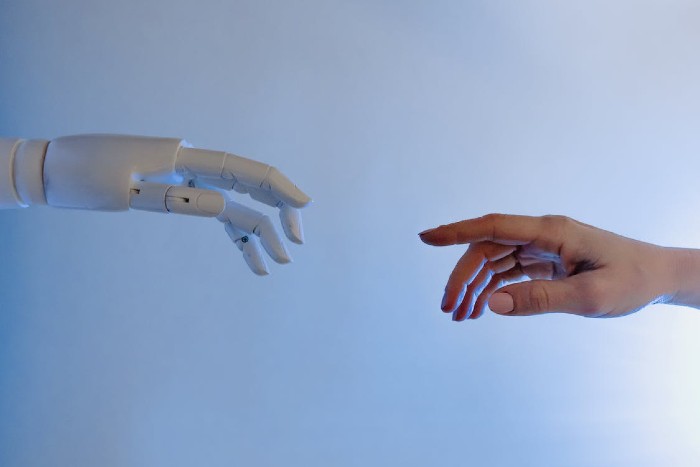Copywriters, look upon these words and despair. Your days are numbered, and your robot overlords are coming to supplant you. New advances in AI have rendered your entire profession obsolete. It’s time to accept your fate and join the cinema projectionists, milkmen and coal miners at the back of the dole queue. Digital copywriting machines can generate cogent long-form copy in seconds, never push back against deadlines, never take holidays and never fall ill.
Even established broadsheet journalists are starting to fear for their jobs.
With AI copywriting tools evolving at an alarming rate, veteran and neophyte copywriters are beginning to fear that their days really are numbered. That their clients will lose sight of their value proposition and become seduced by the quick and easy gains afforded by AI tools.
But is this professional anxiety really warranted? Have the capabilities of AI copywriting been buoyed by hyperbole? And even if the advances in AI copywriting are as impressive as copywriters fear, does that really mean that their craft is doomed to become a quaint anachronism?
In this state of the industry address, we’ll do our best to clarify the capabilities and shortcomings, opportunities and threats that AI represents for copywriters, content marketing agencies and businesses.

New technologies are often steeped in a combination of mystery and promise. The more we find out about its capabilities, the easier it becomes to think of AI copywriting as the solution to all our problems.
For nascent brands trying to establish a credible online presence, AI can seem like a magic carpet that propels them to SEO prominence on a current of keyword-rich content that’s churned out in seconds. Likewise, overworked or cash-strapped freelancers may dream of turning their profession into a passive revenue stream, outsourcing their client work to AI platforms and pocketing the profits. Agencies may also see opportunities to improve their value proposition with volumes of content that far exceed what even their fastest writers can generate, giving clients more bang for their proverbial buck. What’s more, many AI copywriting tools have a freemium pricing model, so users can potentially garner great rewards with little or no risk.
Yet while AI can create passable online copy at scale, the need for quality will always exceed the need for quantity when it comes to online content.
At best, AI-generated copy will need to be thoroughly proofed, edited and corrected by a human copywriter to create content that is of any real value to a human reader. This will inevitably cause bottlenecking in what was imagined to be a fluid pipeline.
At worst, populating a company’s website with AI-generated copy can actually be damaging to its brand credibility. AI can generate passable original copy that passes all the requisite plagiarism checks, but it cannot yield unique insights, harness the knowledge of a specialist or add the kind of value that builds trust.
Perhaps it might be pertinent to start off with a full and honest account of what AI copywriting can do. To understand this, we need to understand how AI copywriting platforms work, and what makes the new crop of headline-grabbers like ChatGPT different from their predecessors.
So, let’s take a peek under the bonnet.

Chatbots and AI copywriting tools work by pulling information from an established dataset. They then use labellers to inform desired output behaviours. These are the linguistic rules and tenets that form the linguistic structures we use in our speech and writing. This enables them to simulate the way in which we learn and process information.
However, the output an AI platform generates is only as good as the dataset it pulls from. In order to speak knowledgeably about a given subject, the dataset it uses needs to include a great deal of information on that subject. Fortunately, these datasets are constantly expanding, but this doesn’t mean that AI is omniscient.
Just like a human copywriter, an AI tool also needs to be given a clear and structured brief to provide it with a set of contextual parameters. Otherwise, the output it generates is likely to go off the rails (because it can’t see where the rails are).
As with most things, users get out what they put in. The more high-quality information the user provides the AI, the better the output is likely to be. However, furnishing AI platforms with this data takes time, and is likely to require a similar degree of desk research as any other copywriting task.
While the capabilities of AI copywriting platforms are certainly impressive, users certainly need to reign in their expectations. Even shiny new tools like ChatGPT, while initially impressive, have their limitations.
Nonetheless, AI does have its uses. It can generate large volumes of content in seconds. Assuming that the user has the time and inclination to furnish it with the right information and parameters, it can attempt to fulfil a brief. Proponents also argue that it can write effective SEO copy by analysing a given topic and identifying the meaning behind certain keywords and phrases. Where copy needs only to provide information, without the need to be readable or engaging (e.g. e-commerce product description pages), AI could also be a potentially useful labour-saving device.
AI copywriting is effective at creating content in great volume within a short space of time. However, the limitations of AI will always mean that human beings are necessary to proof, edit and augment AI-generated copy.
In a nutshell, AI cannot think. The specific type of AI employed in the digital realm today is known as Artificial Narrow Intelligence (ANI), as opposed to the science fiction fare of Artificial General Intelligence. AI focuses on performing one single function or a narrow range of functions. Its market value lies in the fact that it can perform tasks faster and more efficiently than its protein-based counterparts.
But its range of functions is inherently limited. In the case of AI copywriting, the programme knows how to pull information from various sources and reappropriate the language to ensure that it reads as original content.
AI is fundamentally incapable of being funny. When it comes to what makes us laugh, there are simply too many variables at play for AI to successfully replicate humour. There are tools like Punchlines.ai that try to simulate humour, but while these are fun to play with, they fail to capture the essence of what makes a joke. Because while jokes may follow a formula and a set of rules that can be programmed, what makes the joke resonate with us and makes us laugh is too ephemeral to replicate.
Time Magazine’s Corinne Purtill hits the nail right on the head when she says, ‘Humans have vast mental libraries of cultural references and linguistic nuances to draw upon when hearing or telling a joke. AI has access only to the information that humans choose to give it.’
AI can’t arrange a bouquet of sentiments or let forth a deluge of opinion. It cannot sling a simile or mete out a metaphor. It has absolutely no sense of poetic licence and cannot paint vivid pictures with words in the way that a skilled copywriter can.
While florid prose may not be a high priority for your online content, there’s a good chance that your brand’s tone of voice requires a specific vocabulary and literary timbre. Therefore, the copy generated by AI is unlikely to feel consistent with the tone you have already established in your online content.
It works off a predetermined dataset meaning that it can neither yield original insights nor offer a dialectic on the information it finds. It can challenge a thesis by saying that its dataset deems incorrect but it lacks the flexible thinking that original insights require.
And when you’re building a brand, your original insights are your most valuable resource. They are pretty much the only thing that your competitors can never replicate.
AI copywriting pulls information from all over the internet including articles, blog posts, web pages and books. When it is asked to make an argument, it pulls facts and stats from its vast data corpus. But it will not cite its sources or provide backlinks. It cannot compare and contrast the results of different studies and reach its own conclusions.
Therefore, editors must track down any quotes their AI provides and insert backlinks manually, adding more time and effort to the editing process.
There are some forms of copywriting where human involvement is absolutely indispensable. While AI can be trained to approximate the efforts of an inexperienced or low-cost copywriter, it is insufficient to simulate crafts that take a long time to learn and develop such as:
Platforms like Jasper (formerly Jarvis), Copysmith and WriteSonic have been around for some time. But the advent of ChatGPT seems to have reignited the conversation surrounding AI copywriting. While our team had been toying with AI tools prior to ChatGPT’s release in late November 2022, we had to see what this new kid on the deep learning block had to offer.
Our experiences confirmed what we already suspected, but they’re worthy of inclusion here.
Chat Generative Pre-trained Transformer (GPT) is an AI language model created by Open AI – a research body founded by Elon Musk and Sam Altman. While not designed specifically for copywriting, it is able to generate original content for online publication.
Other applications include:
ChatGPT is one of the most advanced language models available. It has been trained on a huge data corpus containing an incredibly diverse range of texts from all over the internet. The most current version at the time of writing (GPT-3) was trained on a dataset of around 570 GB of text data, with 175 billion parameters, making it one of the largest neural networks ever created.
Its huge dataset, advanced contextual understanding and sophisticated natural language model make it one of the best tools for creating text that looks and reads like it was written by a human.
Yet while it boasts some impressive specifications, it is not without its shortcomings, as we quickly found.
Our CEO, head of operations and staff copywriter have all had some fun playing with ChatGPT. Our early testing involved asking the platform some questions and requesting detailed answers. At first glance, the results were impressive. But when closer scrutiny was applied, those results withered under the lights somewhat.
For instance, when asked to deliver 500 words on new trends in SEO (a topic where we can claim some authority), we watched with a combination of incredulity and trepidation as fully formed sentences cascaded across the screen.
The platform identified several important facets of SEO that are likely to inform operations for brands and agencies in the future, including the rise of visual and voice search, user experience, local SEO and, indeed, AI and machine learning. However, it also acknowledged that ‘As a language model, I don’t have knowledge of events or trends that have happened after my knowledge cutoff date of September 2021.’
Here’s a snippet of what the program wrote for us:
“The Rise of Visual Search: Visual search technology is already being used by companies like Pinterest and Google to help users find the products they are looking for. In 2023, visual search is expected to become more important, and SEOs will need to optimise their content to be easily recognized by visual search algorithms. This includes optimising images with relevant alt text and descriptions.
Increased focus on user intent: While optimising for specific keywords will still be important, search engines are increasingly prioritising content that aligns with user intent. This means that websites that can deliver the most relevant and useful content to users will likely see improved rankings.”
Does this look like content created by a human copywriter?
Yes.
Does it look like content created by a good copywriter?
Not so much.
From the icky use of passive voice in the first sentence to the monotonous structure and lack of any real tangible insight, it reads like cheaply outsourced copy. The kind that businesses might get from exhausted and underpaid copywriters on Fiverr eking out a living from high-volume, low-quality copy.
If you ran an SEO agency, would you be proud to have the above snippet on your blog?
Google insists that its priority remains rewarding high-value content, however it’s produced. Therefore, using AI-generated content will not damage your SERP rankings per se. It all depends on the quality of the content.
In August 2022, Google implemented its helpful content update which focused its emphasis towards people-first content. This put paid to much of the algorithm-chasing that the discipline of SEO was becoming. A further spam update in October 2022 was designed to prevent black hat practices employing AI to produce huge volumes of spammy, low-quality content to artificially improve their SEO rankings.
These updates sent out a clear challenge to copywriters, agencies and brands. If you want to rank highly on SERPs, you need to write helpful content. But what exactly is helpful content, and can AI be successfully employed to create it?
In order for Google to deem web copy helpful content, the content needs to be relevant, useful and of high quality. It uses a huge array of metrics to measure this including:
AI can write information that is relevant to keyword searches. It can also sprinkle in any keywords that you give it, and use them in ways that make sense contextually and feel natural. All the while ensuring that content is original and doesn’t fall foul of plagiarism checks.
However, that doesn’t mean that it can generate the kind of unique, insightful thought leadership content that brands rely on to differentiate themselves from the competition.
The best way to determine the value Google will assign to a piece of AI-generated copy is to ask yourself:
If the answers to all these questions are resoundingly negative, the copy is unlikely to scale the highest heights of SERPs.

Practical applications for AI copywriting
Populating your website with AI-generated copy is like replacing every entry of your weekly meal plan with takeaway pizza. You’ll probably survive, but it won’t be good for you.
The more users experiment with AI copywriting platforms, even the really sophisticated ones like ChatGPT, the more apparent their inadequacies become. So, as takeaway pizza can be perfectly acceptable as part of a balanced diet, AI copywriting can be a useful tool in your content marketing repertoire.
Some practical applications for AI copywriting include:
Every copywriter knows the sense of abject dread that comes with writer’s block. The haunting desolation of the blank page, the taunting wink of the cursor. While a quick walk and a coffee are usually enough to get the ideas flowing again, sometimes even the best copywriters need a helping hand.
Inputting a proposed title or H1 into an AI tool can provide writers with a stimulus or outline upon which they can expand or elaborate. Even if the copywriter hates what the tool generates, it gives them a starting point to move away from.
When writers fall short of their word counts but don’t want to pad them out with fluff, AI can help by bolstering the word counts of content without being too tautological. Likewise, when more brevity is needed, AI can condense lengthy copy into something shorter and punchier.
One of the biggest frustrations of SEO copywriting is populating the copy with keywords in ways that feel natural and don’t disrupt the flow of the prose. This is another area where AI can be very helpful. Simply tell it what keywords you need to include, copy and paste your copy and await the results.
Where users need large quantities of copy, and readability and quality are less of a factor, AI copywriting can really shine. It is therefore an excellent tool for writing lots of product descriptions for e-commerce sites or writing unique optimised service pages for different locations.
Why is it that you’re writing your online content?
Sure, you want to improve your (or your client’s) search engine rankings. But to think in terms of SERP rankings is to put the cart before the horse. The whole point of content marketing is to create copy that is of value to the reader, establish the brand as an authoritative resource and help to build the trust on which business relationships are forged. For that content to stand out from what your competitors are offering, it needs to share your perspective, be informed by your unique insights, and speak with confidence and authority on its specialist subject. It is a tool for telling your unique story.
When engaging prospects online, your copy is your brand. Your brand is your baby. And you probably wouldn’t entrust your baby to a robot, no matter how advanced it purports to be.
Content that is not only readable but engaging, relevant, useful and backed with relevant facts, stats, sources and citations is the kind of content on which you can build a brand.
And while AI can be a useful tool in supporting this, it cannot manage it single-handedly.
Want to know something really scary? Everything you’ve just read was created by ChatGPT.
… No, not really.
And therein lies our thesis.
At first glance, AI copywriting certainly looks like a game changer. When one considers its ability to churn out thousands of words in just a few seconds, it’s easy to see the allure of these AI tools. Yet while users may envision an endless stream of content grist for the SEO mill, they must not lose sight of the importance of quality.
Yes, search engine crawlers value websites that are packed with content. But they also increasingly value quality over quantity. The kind of content that keeps readers scrolling and coming back for more is inevitably the kind of content that Google will nudge up on page rankings. And as superficially impressive as AI technology is, the vanilla and vaguely lifeless nature of AI copy will always keep it from resonating with human readers, unless the human touch is employed.
The most likely scenario is that AI copywriting supplements the efforts of human copywriters rather than supplanting them.
A future that we at Write Arm are more than happy to embrace.
Our AI content editing service can add the little nuances of copywriting craft that make your copy more compelling, more authoritative and more representative of your brand.











